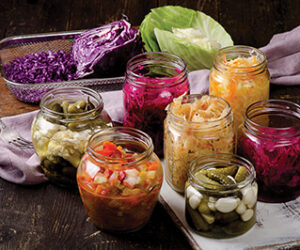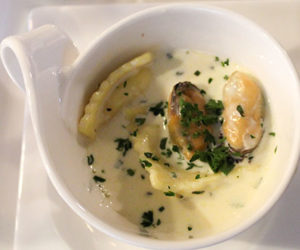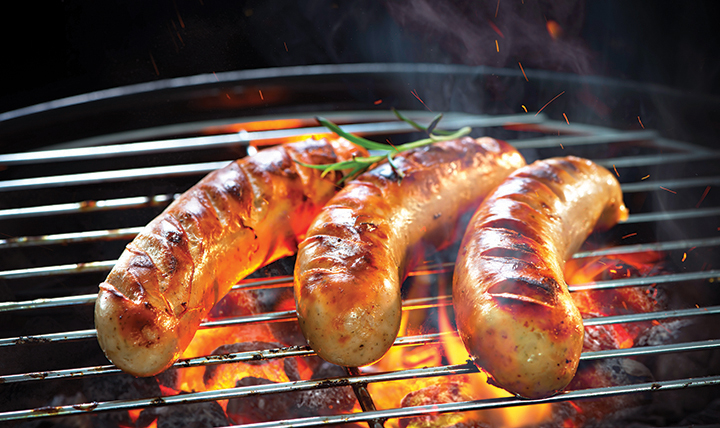
Sausage and wine have been popular together since before the time of the Caesars. Many of the sausages we enjoy in North America today have origins in Europe and some recipes can be traced back to ancient Roman cookbooks. At its most basic, the nature of sausage is reflected in the name. “Sausage” in English is derived through Anglo-French from Latin “salsus,” meaning salted. Meat is minced or ground, salted and seasoned, and usually stuffed into a casing. Today, I will share with you my favorite recipe for mild Italian sausage, made with homemade red wine in the mix. Also made with wine is one of my favorite smoked sausages, linguiça, or Portuguese sausage. Both pair beautifully with hand-crafted wine.
Italian sausage is a North American term for a product that resembles some of the popular styles in Italy, where dozens of different regional and traditional sausages are enjoyed. Fried or grilled in the casing, such sausages are served on sandwiches with peppers and onions, on top of spaghetti with marinara sauce, or simply presented on a plate to enjoy with a glass of wine. Removed from the casing (or never stuffed to begin with), it can be found in pasta sauces, on pizzas, and as filling for stuffed pastas like ravioli. My version, like many others, is a 100% pork recipe. Fennel seeds, garlic, and fresh parsley make it instantly identifiable as “Italian.” Since I like to incorporate wine into my cooking when I can, I include a homemade red wine in the meat mixture. If you want to make hot Italian sausage instead of mild, simply add cayenne pepper at a rate of ¼ to ½ tsp. per pound (454 g) of meat.
Linguiça is another European style sausage that I have long enjoyed. After I bought a smoker, this Portuguese sausage was one of the first recipes I developed. Richly flavored with three different kinds of paprika, it becomes even more savory with time spent hanging in hickory smoke. This recipe is also 100% pork and includes red wine. A few years ago I had the good fortune of being able to buy some grapes at harvest time from a friend who had just bought a vineyard that included the Portuguese grape variety Tinta Cão. While traditionally used in producing Port-style dessert wines, it also makes a delicious dry red table wine that pairs very nicely with this mildly spicy Iberian food.
Sausage making basics
Two basic pieces of equipment are required for sausage making: A grinder and a stuffer. Just as with winemaking equipment, there are some simple manual devices that will get you started, but you may want to upgrade if this becomes a regular hobby. In the pictures included here, you will see the electric grinder and piston-style stuffer that I have settled on. They have proved very satisfactory for my level of production of several batches per year of 5–6 pounds (2.3–2.7 kg) each. Of course, that’s a lot of one kind of sausage for my wife and I. Sometimes we split a batch, as we did for this article, between Italian sausage and linguiça. What we don’t cook and eat in a day or two, we freeze on sheet pans and then store in zipper bags in the freezer.
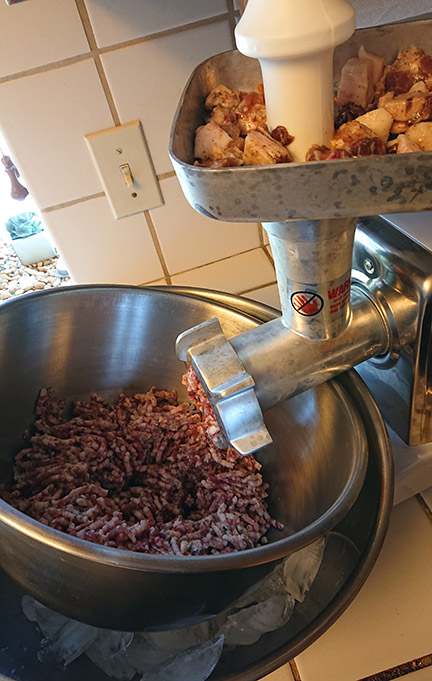
In the linguiça recipe, you will see that I use pink salt/Prague powder #1/insta cure #1 as an ingredient. That curing salt is 6.25% sodium nitrite and the balance is sodium chloride (table salt). The other prominent curing salt you may run across in this hobby is Prague powder #2 with the same amount of sodium nitrite plus 4% sodium nitrate. Both salts are dyed pink so they don’t get mistaken for table salt in the kitchen. Besides assuring the color and flavor of cured meat, these salts protect against the growth of spoilage organisms, most notably Clostridium botulinum, in sausages that spend some time at other than cold temperatures. Cure #1 is for short-term applications, such as the 90-minute “cool” smoking period in my recipe. If you want to make the same recipe as a raw sausage without smoking, to be refrigerated or frozen, you may leave it out. For longer storage outside the fridge, as in drying a salami, the nitrate in cure #2 breaks down to nitrite, providing extended protection. If you want to get the character of cured sausage but avoid nitrate and nitrite salts, you can buy celery extract powder that has significant levels of naturally occurring nitrates. Some salamis also have a sour lactic tang as part of the flavor profile. The lactic acid is produced through bacterial fermentation. Because I love putting microbes to work, I have made a few dried sausages using Chr Hansen Bactiferm F-RM-52 that contains Lactobacillus sakei and Staphylococcus carnosus, much as we use freeze-dried cultures of Oenococcus oeni to initiate malolactic fermentation in our wines.
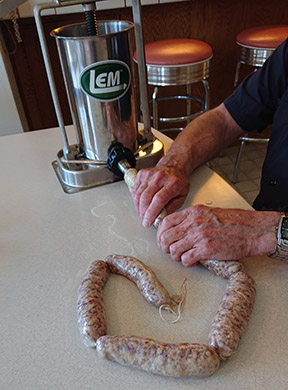
What meat you use in what sausage is entirely your choice. Modern pork is so lean that adding pork fatback (also called back fat), as I do here, really helps assure a juicy and succulent product. You will probably need to talk to your butcher to buy it, but it is very inexpensive (I order my sausage meats from a local custom meat purveyor and pick up the combination I want the next day.) In the interest of expanding my sausage horizons, I have also made sausages from meats beyond pork and beef. I have boned and ground chicken thighs and turkey thighs, and around Thanksgiving (when turkeys go on sale at supermarkets) my wife has bought whole frozen turkeys that we thaw, bone and skin, and then grind for sausage. I have also used lamb leg meat for making the North African sausage Merguez and it was delicious. For that one, I wanted to make breakfast-size sausages, smaller than a “standard” dinner sausage.
That leads me to a discussion of casing: The small ones are sheep intestine casings and do, indeed, make breakfast-size links. Hog casings are what I use most often, making sausages roughly one inch (2.5 cm) in diameter. The biggest natural casings for home use are beef middles, used for sausages like bologna or summer sausage. There are also a variety of manufactured casings using collagen, plastic, and other materials. You may be able to find the casings you need at your local butcher shop. If not, a simple Google search for sausage casings will result in numerous options to order online. I have sourced most of my equipment and (non-meat) supplies from sausagemaker.com and lemproducts.com.
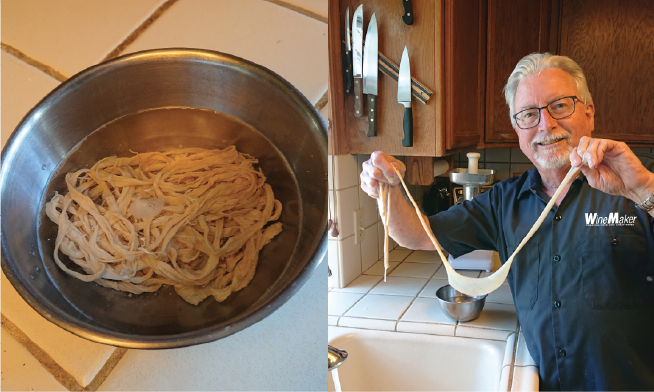
As with any food or beverage hobby, cleaning and sanitation are very important. Clean all of your work surfaces like you would for any cooking project, and sanitize any surface that will be in direct contact with your sausages. Keep in mind that meat can spoil much more quickly than grapes. I like to use a 70% ethanol solution in a spray bottle to sanitize the Formica tabletop that I do my stuffing on. Another protection against spoilage is to keep everything as cold as possible while you work. That also helps keep the fat from smearing, so you get a better texture.
This story is, of course, intended as an introduction to making sausage at home. If you’d like to take the hobby further I would recommend getting a good book on the subject. I use (and like) Charcuterie by Ruhlman and Polcyn as a basic text and, for more advanced fermented sausages: The Art of Making Fermented Sausages by Marianski and Marianski.
Alright, armed with this basic information, let’s open a bottle of wine and get to the recipes.
Recipes
Italian Sausage
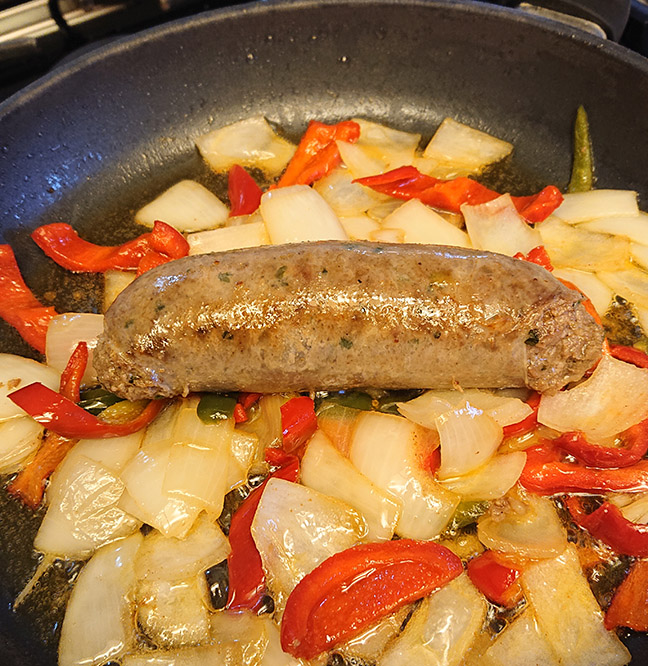
Ingredients
Meat:
4 lbs. (1.8 kg) boneless pork butt (shoulder)
1 lb. (0.45 kg) pork fatback
First addition:
1½ tsp. black pepper
4 tsp. toasted fennel seeds (toss in a nonstick pan over medium heat to toast)
1 tsp. paprika
1 cup fresh parsley, chopped
1 head of garlic, peeled and chopped
(Optional: 1–2 tsp. cayenne powder to make hot Italian sausage)
Second addition:
8 tsp. kosher salt
7 tsp. sugar
Third addition:
¾ cup homemade red wine
¼ cup red wine vinegar
Other:
Hog casings packed in salt
Step by Step
Clean and sanitize surfaces. Cube fat and put in freezer. Cube pork. Toss pork cubes and frozen fat cubes with spices. Add the salt and sugar and mix again. Chill in the fridge.
Mix vinegar with wine and chill. Chill grinder parts.
Soak about four hog casings 30–60 minutes in tepid water. Rinse with cool water, including running a plug of water through each. Keep in a fresh bowl of cool water. (If you just want bulk Italian sausage without the casings, you can skip this part.)
Set up the grinder and get out the chilled sausage mixture. Grind on medium into a bowl set in ice. Add wine and vinegar and mix into ground meat. Fry a test patty and taste. Adjust seasoning as needed to fit your taste.
Start filling a casing, squeeze out air, and tie off with kitchen twine. Stuff to desired link sizes, twisting opposite directions each time. Coil on sheet pans lined with wax paper. Refrigerate or freeze, then cut apart the links. Use within a couple of days or store frozen sausages in zipper bags. Grill or fry thawed sausages until just cooked through to maintain juiciness.
Notes:
This sausage recipe uses a medium grind, producing the typical somewhat rustic character of most Italian sausage.
Aromas and flavors are savory meat and toasted fennel seed. The sausage is juicy but tender and has a very typically Italian flavor profile. The hints of vinegar and wine brighten the overall palate.
This Italian sausage pairs very nicely with a fruity red wine.
Linguiça
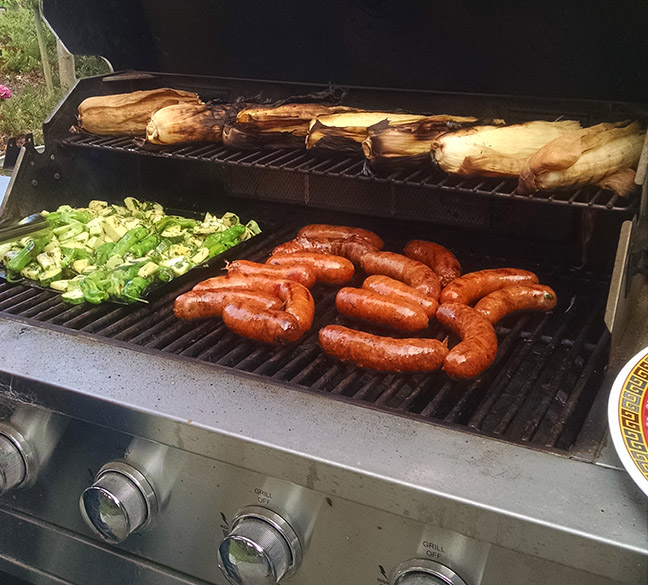
Ingredients
Meat:
5 lbs. (2.27 kg) boneless pork butt (shoulder)
1 lb. (0.45 kg) pork fatback
First addition:
3 Tbsp. chopped garlic
½ cup homemade dry red wine
2 Tbsp. sweet paprika
2 Tbsp. smoked paprika
1 tsp. smoked hot paprika
2 tsp. dried oregano
1 tsp. ground white pepper
1 tsp. ground black pepper
¼ tsp. ground coriander seed
Second addition:
40 g kosher salt
6 g pink salt (Prague powder #1)
Other:
Hog casings packed in salt
Hickory chips for smoking
Step by Step
Clean and sanitize surfaces. Cube fat and put in freezer. Cube pork. Toss pork cubes and frozen fat cubes with wine and spices. Add the salts and mix again. Chill in fridge.
Chill grinder parts. Soak about 4 hog casings 30–60 minutes in tepid water. Rinse with cool water, including running a plug of water through each. Keep in a fresh bowl of cool water.
Set up the grinder and get out the chilled sausage mixture. Grind on medium into a bowl set in ice. Fry a test patty and taste. Adjust seasoning if needed.
Start filling a casing, squeeze out air, and tie off with kitchen twine. Stuff to desired links, twisting opposite directions each time. Coil on a rack as they fill. Air-dry uncovered in refrigerator for about one hour.
Hang links on smoking rack and place in smoker. Smoke over hickory for 90 minutes at 140 °F (60 °C). Remove
to platter.
When ready, cut apart links and grill over low-medium flame for 10 to 15 minutes (smoking at 140° F/60 °C does not make the pork fully cooked). Watch for flare-ups!
Notes:
Special thanks on this recipe to former co-worker and fermentation collaborator Kimi Anderson who developed it with me.
The flavor profile is smoky, mildly spicy, and richly meaty. We have enjoyed it with eggs and potatoes, with pilaf and grilled vegetables, and as part of a small-plates tapas style buffet.
This sausage pairs beautifully with the same red wine you use in it. If you are fortunate enough to make a Portuguese variety as a dry red wine, then by all means serve that. When paired with eggs, whether for brunch or for dinner, sparkling wine is a great companion.



